Exposure
Control
| P (Programmed) S (Shutter Priority) A (Aperture-Priority) M (Manual) TTL Flash AE The Viewfinder information in the FA will react accordingly when the individual exposure control mode changes. Illustration here is the full information shown, but in individual mode, only selective and useful information is provided. |
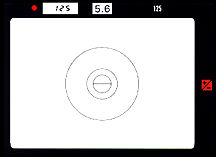 |
P
(Programmed)
Mode
In the programmed mode, you
let the camera select both the aperture and shutter speed for you. The optimum
combination of shutter speed and aperture is automatically set by the FA's
microcomputer, depending upon scene brightness, film speed, and lens focal
length in use. The Nikon FA has a special built-in function that works very
well with the AI-S lenses, as for short lenses (less than 135mm), the FA uses
a normal program to ensure correct exposure. But with telephotos of 135mm or
longer, the camera automatically swtches to a special highspeed program to
reduce the possibility of camera shake caused by slow shutter speeds. The P
mode not only greatly simplifies operation but also lets you concentrate on
picture composition, making it desirable for fast-breaking action when there
isn't time to think.
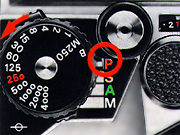 |
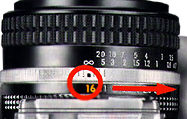 |
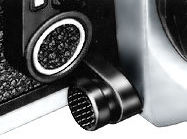 |
To setup your FA for programmed mode is simple and straight forward (Provided you are using an AI-S Nikkor Lens). Just note the following:
1. Set the mode selector to
P;
2. Set the lens to its minimum aperture (the largest f-number - If an
AI-S lens is used, the f-number is coded in orange color). The shutter speed dial can
be set at any position except M250 and B;
3. Confirm that automatic
multi-pattern metering is in operation by making sure that the metering
control button is in the norma "out" position and the red index is not on top
(refer to earliar section for metering).
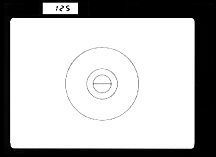 |
When you view through the viewfinder, it has only a LCD to shown, depress the shutter release button halfway will activate the meter and you will see the LCD showing the shutter speed (as a reciprocal ) selected by the camera to provide correct exposure - because in this mode, the camera built in computer circuitry will first determine the exposure (By way of Matrix Mtering) and adjust according to the lens type to which program mode should be selected (135mm & below for normal or beyond 135mm for higher speed priority program) and only the shutter speed info is provided for the user. |
| Warning Indications (In some cases
where the LCD shown with these warning letters): If the LCD shows 'Hi', this means the scene is too-bright, indicating over-exposure may occur. In this case, use a neutral density (ND) filter (with different grades); a polorizer will take in extra 2 stops and see if it helps or change to a slower speed film. If the LCD displays 'Lo', this means the scene is too dark, indicating under-exposure may occur. Use an artificial light source e.g. electronic flash, change to faster speed film or remounting a faster lens speed lens and see if it helps. If the LCD shows 'FEE', this means the aperture ring is not set at the smallest aperture(largest f-number) on the lens. Reset the lens to its minimum aperture. When using an AI-modified Nikkor lens, a Nikon Teleconverter TC-200, TC-300, or TC-14, or a PK ring, this warning will not appear. So, be sure to set the aperture to its minimum. However, even if the aperture is set incorrectly, you can stil get the correct exposure (in most cases), but the programmed aperture will be restricted to the range between the lens maximum aperture and the actual aperture you set on the lens. Nobody understand why the "FEE' was used in this case, becoz' dating back to the Canon AE1 in 1975, it was used as a warning signal. I suppose this is adopted as a common understanding between all Japanese manufacturers.. |
Since it is all about lenses that can made this mode works. AI-S in particular which has a focal length identification notch to communicate with the camera to relay the type of lenses (Restrictive to focal length information during that stage). The current autofocus lenses, can be classified all of them as AI-S but with many other information being relayed to the AF body by means of extra pin and contacts. The AF lenses, has an added advantage, as they can be locked at the largest f number (Minimum aperture value), you can used that in this programmed mode to avoid accidental shifting of the aperture.
The Nikkor lenses (AI, AI-converted) or the AF Nikkors are not the only two options. The earlier E series lenses (Perhaps you have forgotten that, huh ?) can also be classified as AI-S group of Nikkor Optics which can work perfectly in the programmed mode in the FA. Not sure ? Okay, the Nikon FA is not the first Nikon body that can go 'Program AE' - the super compact body of FG in 1981 was the first. It has a programmed mode as well and the Nikon E series lenses (However, it was called 'Nikon Lens' - and the Nikkor was not used) was the first batch of lenses from Nikon has those communication tabs and contacts incorporated (But they are also the first that doesn't have a meter coupling ridge to work with older Nikon bodies).
Programmed Exposure Measurement Graph
In the programmed automatic
exposure mode, the FA provides the optimum combination of aperture and shutter
speed to match the film speed in use and the brightness of the scene. These
combinations were arrived at through intensive research and then fed into the
FA's microcomputer to provide a predetermined exposure program. Thus, when
actual exposure measurement takes place at the time of shooting, the ideal
combination is selected, resulting in usually pretty good exposures for every
shot.
Moreover, the FA features two different exposure programs to
match the lens focal length (applies only to Al-S Nikkor and Nikon Series E
lenses). The normal program is for lenses less than 135mm; the high-speed
program is for 135mm and longer (including zoom lenses whose longest focal
length exceeds 135mm). To minimize camera shake with telephoto lenses, the
high speed program does not go below 1/125 sec until the lens maximum aperture
is reached: then slower speeds are progressively chosen. With all other
lenses, the normal program is in operation. The high-speed program is also
automatically chosen by the FA when a Nikon Teleconverter TC-201, TC-301,
TC-14A, or TC-14B is attached to Al-S, Nikon Series E, and AI-Nikkor
(Including AI-modified) lenses; with Nikon Teleconverters TC-200, TC-300, or
TC-14, the normal program is in operation.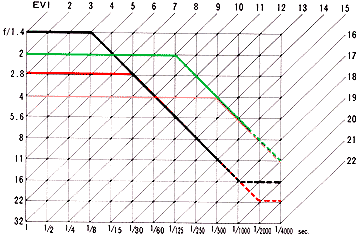
Credit:
(Programmed illustration below are adopted from the Nikon FA's
instruction manual supplied by Miss Rissa, Shriro Malaysia - the local Nikon
distributor, you may use it as a reference for discussion
purposes)
The
black line represents the norma program for an AI-S or AI-Nikkor 50mmf/1.4
lens with ASA/ISO 100 film, whereas the green line represents the high-speed
program for an Al-S Nikkor 135mm l/2 lens. For lenses with different maximum
apertures (e.g. an AI-S or AI-Nikkor 24mm f/2 8 which is indicated by a red
line or an Al-S Nikkor 200mm f/4 by a pink line), the graph is read from that
particular aperture until intersection with the diagonal line and then
downward along the same line. Solid program lines represent automatic multi
-pattern metering, whereas solid and dotted lines centerweighted metering. In
extremely bright lighting situations such as snow scenes, scenes at the beach
etc. exposure compensation of approx +2 EV is required with conventional
centerweighted metering. Taking this into consideration, automatic multi
pattern metering is pre-programmed to automatically make exposure compensation
by reducing extreme brightness to EV 16-1/3.
1)The following lenses cannot be used in the P or S mode
- Zoom-Nikkor 50-300mm f/4 5 ED (older Al type without orange minimum aperture on ADR sca/e)
- Al modified Micro-Nikkor 105mm f/4
2)When using a Nikon Teleconverfer
TC 200, TC-300 or TC 14, the shutter speed may vary by approx. one step from
that displayed in the view finder. However you will still obtain the accepttable
good exposure.
3)With a teleconverter attached, shutter speeds become s/ower than those indicated
by the normal or high-speed program line, respectively. Similarly, with an
Al modified Nikkor or PK ring attached. shutter speeds become slower. While
the actual shutter speed will be the one indicaled by the LCD and correct
exposure is assured even in these cases, be sure to check the LCD to avoid
blurred images at slower shutter speeds.
| Back | Next | The Shutter Priority AE
6/13 parts